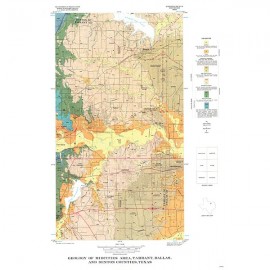Geological Circulars
-
Books & Reports
- Reports of Investigations
- Guidebooks
- Udden Series
- Geological Circulars
- Down To Earth
- Atlases of Major Oil and Gas Reservoirs
- Texas Memorial Museum Publications
- Environmental Geologic Atlas of the Texas Coastal Zone
- Mineral Resource Circulars
- Other Reports
- Seminars and Workshops
- Handbooks
- Submerged Lands of Texas
- Symposia
- Annual Reports
- Open File Reports
-
Maps & Cross Sections
- Thematic Maps
- Miscellaneous Maps, Charts & Sections
- Geologic Atlas of Texas
- STATEMAP Project Maps
- Geologic Quadrangle Maps
- Cross Sections
- Highway Geology Map
- Energy and Mineral Resource Maps
- Shoreline Change and Other Posters
- Wilcox Group, East Texas, Geological / Hydrological Folios
- Bouguer Gravity Atlas of Texas
- River Basin Regional Studies
- Featured Maps
- Posters
- Teachers & the Public
-
Geological Society Publications
- Gulf Coast Association of Geological Societies
- Alabama Geological Society
- Austin Geological Society
- Corpus Christi Geological Society
- Houston Geological Society
- Lafayette Geological Society
- Mississippi Geological Society
- New Orleans Geological Society
- South Texas Geological Society
- GCS SEPM Publications
- Historic BEG & UT Series
Mineral Lands in the City of Dallas
GC7801
A free, digital version of this publication can be found on: Texas ScholarWorks
GC7801. Mineral Lands in the City of Dallas, by A. E. St. Clair. 14 p., 15 figs., 3 tables, 1 plate, 1978. ISSN: 0082-3309. Print.
To purchase this publication as a downloadable PDF, please order GC7801D.
ABSTRACT
Surface mining, with its accompanying dust, noise, truck traffic, and land disruption, generally conflicts with most urban land uses. Urban development, however, is dependent upon the availability of nearby mineral resources for the construction of roads and buildings. As a result of this conflict, many urban areas are now faced with rapidly rising construction costs, partly because of a failure to recognize and use aggregate resources before building over such resources or making them unavailable by zoning.
Applying the concept of sequential land use to the problem of mining in urban areas can help prevent loss of resources by encouraging exploitation of minerals before development of the land. Mining can therefore be considered an interim land use, after which the land can be reclaimed for recreational, residential, or commercial uses.
The first step in implementing this reclamation policy is to locate areas with resource potential, as well as areas from which minerals have already been extracted. After the resources have been identified, decisions that affect use of these areas can be made with consideration of the mineral potential of the land. Comparing the advantages of sequential land use of mineral areas with the advantages of the other alternatives, such as urbanization or zoning to prevent mining, first requires information on the availability and the location of potential resources with respect to the urban area. Such a comparison also requires data on the types and effects of mining, requirements and costs of reclamation, and projected demand for resources. Considering all these factors promotes informed land use decisions and prevents both unnecessary loss of resources and increases in construction costs.
In 1976, the City of Dallas contracted with the Bureau of Economic Geology, The University of Texas at Austin, to study mineral lands within the City of Dallas. The purpose of the project was to delineate mineral lands, to describe alternatives for reclaiming mined land, and to evaluate the economic impact of zoning mineral lands. This study was designed to provide basic data for policies to ensure availability of mineral resources, and to promote the use of these resources with minimal long term environmental disruption.
Keywords: mineral lands, minerals, surface mining, urban geology, Dallas, Texas
Citation
St. Clair, A. E., 1978, Mineral Lands in the City of Dallas: The University of Texas at Austin, Bureau of Economic Geology, Geological Circular 78-1, 14 p.






